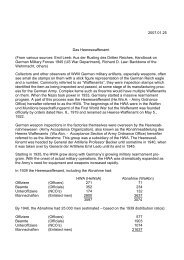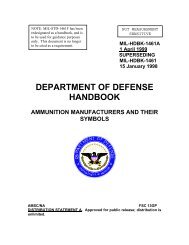Explosives-Nature, Use, Effects and Application.pdf
Explosives-Nature, Use, Effects and Application.pdf
Explosives-Nature, Use, Effects and Application.pdf
Create successful ePaper yourself
Turn your PDF publications into a flip-book with our unique Google optimized e-Paper software.
powder to granules as large as 1.27 cm (1/2 in) in diameter. The burning speed of black powder,<br />
<strong>and</strong> therefore to a certain extent its strength, is controlled by the size of the granulation. Large<br />
grains of powder burn more slowly than fine grains <strong>and</strong> are consequently less sudden in their<br />
action.<br />
Black powder does not deteriorate with age, even if it has been submerged in water. Once black<br />
powder dries out, it is just as effective <strong>and</strong> dangerous an explosive as it was the day it was<br />
manufactured.<br />
Sensitivity to friction, heat, impact, <strong>and</strong> sparks makes black powder one of the most dangerous<br />
explosives to h<strong>and</strong>le. It is particularly sensitive to both electrically <strong>and</strong> nonelectrically generated<br />
sparks <strong>and</strong> should, therefore, be h<strong>and</strong>led with wooden or plastic tools. As a further precaution,<br />
the body should be grounded before black powder is h<strong>and</strong>led.<br />
Because of its slow action <strong>and</strong> consequent heaving or pushing effect, black powder was for years<br />
the sole commercial blasting agent. Though it has been replaced by dynamite in most blasting<br />
applications, black powder is still used for certain special operations. For this purpose it is<br />
manufactured in varying granulations to enable the customer to match the powder to the specific<br />
application, <strong>and</strong> packaged in 11.36 kg (25-lb) metal kegs. For commercial blasting, black powder<br />
is also pressed into cylinders measuring 5.08 cm (2 in) by 3.175 cm (1 1/4 in). Some cylinders<br />
have a 0.9525 cm (3/8-in) hole through their center so that an electric squib may be inserted or so<br />
that the cylinders may be laced together on a length of fuse. In cylinder form, black powder is<br />
usually wrapped in paper to form a stick about 20.32 cm (8 in) in length <strong>and</strong> packed in 11.36 kg<br />
(25 lb) <strong>and</strong> 22.73 kg (50 lb) cases for sale.<br />
As a blasting charge, black powder has about half the strength of TNT, <strong>and</strong> because the basic<br />
ingredients can be readily acquired in any community, it has become the favorite homemade<br />
explosive of bombers in the United States. Black <strong>and</strong> smokeless powder, whether homemade or<br />
commercial, will probably be the explosives most often encountered in pipe bombs. When<br />
confined inside a pipe <strong>and</strong> provided with a safety fuse, no blasting cap is needed to initiate the<br />
powder, because the flame from the end of the fuse is sufficient to cause the explosion of the<br />
bomb. It should be noted that any sparks resulting from an attempt to dismantle a pipe bomb<br />
may produce the same results. Therefore, a discovered pipe bomb should only be h<strong>and</strong>led by<br />
specially trained personnel.<br />
Perhaps the most common use of black powder in routine work with explosives is in the<br />
manufacture of safety fuse. Since its burning rate can easily be regulated in production, black<br />
powder is widely used as the core burning powder in the safety fuse used commercially, <strong>and</strong> by<br />
the military to provide a uniform delay time prior to an explosion.<br />
Safety fuse is used for detonating explosives nonelectrically. Normally, its purpose is to transmit<br />
a flame at a continuous <strong>and</strong> uniform rate to a nonelectric blasting cap. There are two common<br />
burning rates for safety fuse. The most frequently encountered fuse burns at the rate of 40 s per<br />
0.305 m, while a less common type is designed to burn at the rate of 30 s per 0.305 m.<br />
Although safety fuse is designed for use with nonelectric blasting caps, it may, as previously<br />
noted, be used by bombers as a direct means of initiating a low explosive main charge. A delay<br />
element in itself, the safety fuse can be used to allow the bomber time to leave the scene of the<br />
104




